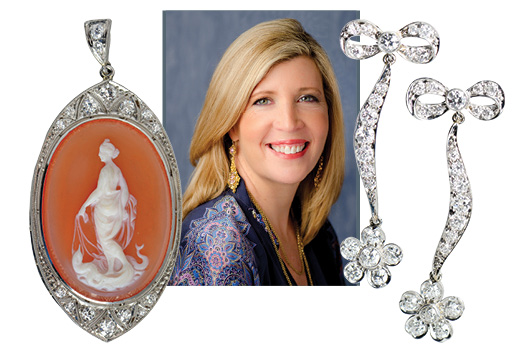
Lisa Stockhammer-Mial, owner of online retailer The Three Graces, explains whether it pays to buy jewelry in need of restorations.
What considerations are important in assessing jewelry needing repairs?
Condition is a huge issue for us. We sell on a website where condition is listed. Clients who are looking for antique pieces care about the authenticity, and if the piece has three new parts, it takes away from that.
The question you have to ask is whether jewelry that is still intrinsically lovely or hard to find is worth the money and time you might have to spend, or the skill needed, to make repairs. We obviously need to pay less for an article that has more work needed, to accommodate for the restoration. It’s a judgment call between beauty, price and aesthetics.
Within that framework, what types of repairs would be acceptable?
Rings that have been sized properly or just need a restoration in the shank aren’t a problem. A brooch that’s had fittings repaired well or just needs silver solder taken off a little spot and put on correctly, bracelet clasp changes, if appropriate and well done — those type of minor things would never stop us from purchasing something. Earring wire or post or fitting changes for earrings, when done correctly, don’t affect value. The only time that might come into play is with very old jewelry like Georgian earrings, where people might want original fittings.
Occasionally, multi-stone pieces have a few small stones that have changed. For instance, they used to be all old European diamonds, and we find a few brilliant cuts. That’s normally not a problem. If it were the biggest diamond in the piece, however, we probably wouldn’t buy it.
What type of repairs would definitely rule out buying a piece?
Enamel loss is a consideration. If it’s minor, where we fill in little bits here and there, we may consider taking it on, depending on how beautiful the piece is. But we see a lot of older pieces with new enamel and tend to stay away from those. When you tilt the piece and look at it under bright light, the re-enameled parts are shiny and glossy and easily noticeable.
We rarely buy dented pieces. Tiny dents can be dealt with, but often they don’t come out exactly right or the amount of effort isn’t worth it. With pieces that have stones changed, or the stones need repolishing or are chipped or worn within an inch of their life, the amount of labor usually isn’t worth it, unless it’s something spectacular.
Are there particular types of jewelry prone to needing lots of repair?
Rings get the most wear, so we’re most vigilant about buying them. From a distance, one might look okay, but closer examination might show that every single tip and prong is gone. And that can be a time-consuming and sometimes stressful repair. Also prone to damage are Art Deco rings with tiny channel-set stones. People love these, and the workmanship is absolutely gorgeous, but some of these stones are less than 1 millimeter by 1 millimeter, so the chances of them falling out over time are high.
Sometimes Victorian pieces were bloomed — 14-karat gold with an acid wash of 18-karat gold over it — and they may get chipped or damaged or wear away and have been partially restored. If we see that, we don’t usually take them on.
Image: The Three GracesArticle from the Rapaport Magazine - December 2019. To subscribe click here.